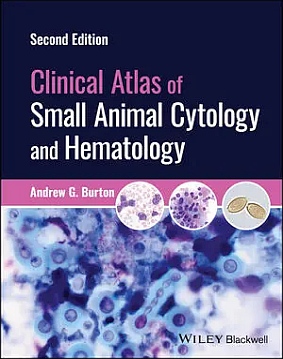
HOME >> 海外出版社刊 洋書販売 新着書籍 >>
Clinical Atlas of Small Animal Cytology and Hematology, 2E

Wiley-Blackwell
| Author | : | Andrew G. Burton |
価格:27,170円 (本体 24,700円+税) 送料サービス
・Release: 2024
・ISBN: 9781119985624
・576 Pages
・Trim Size: 221 X 30.5 X 279.4 ・Hardcover
Description
Clinical Atlas of Small Animal Cytology and Hematology
A comprehensive image-based reference to all aspects of small animal cytology and hematology, including sample collection and handling
Clinical Atlas of Small Animal Cytology and Hematology, Second Edition is an essential, comprehensive resource for all veterinary professionals preparing and evaluating cytology and blood samples. Featuring hundreds of large, high-quality images, this fully updated new edition provides an even more extensive collection of exceptional photomicrographs, accompanied by detailed descriptions, figure legends and annotations to guide readers through the diagnostic process.
The Second Edition adds an extensive new hematology section, new chapters detailing sample acquisition and preparation, and many new diseases across all chapters. Each section provides a detailed description of the microscopic appearance, clinical considerations, and prognosis for each disease, using a bullet point format to promote rapid review for efficient, evidence-based clinical decision making.
Clinical Atlas of Small Animal Cytology and Hematology features:
- More than 750 high-quality cytology and hematology images
- 6 new chapters, including detailed sections on sample acquisition and the preparation and staining of cytology and hematology slides
- A comprehensive hematology section including an easy-to-follow blood smear interpretation guide, and detailed chapters describing erythrocytes, leukocytes, platelets and background features
- Updated cytology sections with new diseases and images in all chapters
Easy to use, with superior quality images and detailed yet succinct clinical information, Clinical Atlas of Small Animal Cytology and Hematology is a powerful resource to help improve confidence and skill in the interpretation of cytology and hematology samples, and in turn positively impact patient care and outcomes.
Table of Contents
- Preface xi
- Acknowledgments xiii
- 1 Cytology Sampling and Preparation 1
- 1.1 Cytology 1
- 1.2 Sample Collection and Preparation 1
- 1.3 Sample Staining 7
- 1.4 Sample Handling and Storage 8
- 2 Cytologic Analysis of Cells 11
- 2.1 Approach to Cytology Samples 11
- 2.2 Sample Quality and Background 11
- 2.3 Cell Types 15
- 2.4 Cell Shape, Distribution, and Features 29
- 2.5 Benign Versus Malignant 30
- 3 Infectious Agents 45
- 3.1 Fungi 45
- 3.2 Oomycetes 56
- 3.3 Algae 56
- 3.4 Mesomycetozoea 58
- 3.5 Protozoa 58
- 3.6 Helminths 65
- 3.7 Bacteria 69
- 3.8 Ectoparasites 75
- 4 Integument 85
- 4.1 Cutaneous and Subcutaneous Lesions 85
- 5 Hemolymphatic 139
- 5.1 Lymph Nodes 139
- 5.2 Spleen 153
- 5.3 Thymus 167
- 5.4 Bone Marrow 170
- 6 Body Cavity Fluids 193
- 6.1 General Classification 193
- 6.2 Specific Effusions 197
- 7 Musculoskeletal 211
- 7.1 Bone 211
- 7.2 Joints 219
- 7.3 Muscle 226
- 8 Hepatobiliary 235
- 8.1 Liver 235
- 8.2 Biliary Tract 250
- 9 Digestive System 255
- 9.1 Salivary Glands 255
- 9.2 Stomach/Intestines 258
- 9.3 Feces 267
- 9.4 Pancreas 272
- 10 Urinary 285
- 10.1 Kidney 285
- 10.2 Bladder 291
- 10.3 Urine 294
- 10.4 Urinary Crystals 298
- 10.5 Urinary Casts 303
- 11 Respiratory 311
- 11.1 Nasal Cavity 311
- 11.2 Lung 317
- 11.3 Bronchoalveolar Lavage/Transtracheal Wash 320
- 12 Endocrine 331
- 12.1 Thyroid 331
- 12.2 Parathyroid 335
- 12.3 Chemoreceptor Tumors 336
- 12.4 Adrenal Gland 338
- 12.5 Pituitary Gland 340
- 13 Reproductive 345
- Male 345
- 13.1 Testes 345
- 13.2 Semen Analysis 350
- 13.3 Prostate 350
- 13.4 Penis 358
- Female 358
- 13.5 Ovary 358
- 13.6 Mammary Glands 361
- 13.7 Vaginal Cytology 366
- 14 Neurologic 379
- 14.1 Brain 379
- 14.2 Cerebrospinal Fluid 386
- 14.3 Spinal Cord 400
- 15 Ocular and Special Senses 405
- 15.1 Eyes: Cornea 405
- 15.2 Eyes: Conjunctiva 409
- 15.3 Ears 412
- 16 Blood Smear Preparation and Evaluation 421
- 16.1 The Importance of Blood Smear Evaluation 421
- 16.2 Making a Blood Smear 421
- 16.3 Blood Smear Staining and Handling 425
- 16.4 Blood Smear Evaluation 427
- 16.5 Hematology Procedures and Techniques 430
- 17 Erythrocytes 433
- 17.1 Approach to Evaluating Red Blood Cells 433
- 17.2 Red Blood Cell Distribution 433
- 17.3 Red Blood Cell Morphology 438
- 17.4 Red Blood Cell Inclusions 456
- 17.5 Red Blood Cell Neoplasia 461
- 17.6 Red Blood Cell Infectious Agents 462
- 18 Leukocytes 475
- 18.1 Approach to Evaluating Leukocytes 475
- 18.2 Neutrophils 476
- 18.3 Neutrophil Inclusions 484
- 18.4 Eosinophils 488
- 18.5 Basophils 489
- 18.6 Mast Cells 491
- 18.7 Monocytes 492
- 18.8 Lymphocytes 495
- 18.9 Leukocyte Neoplasia 498
- 18.10 Leukocyte Infectious Agents 504
- 19 Platelets 515
- 19.1 Approach to Evaluating Platelets 515
- 19.2 Platelet Distribution 515
- 19.3 Platelet Morphology 518
- 19.4 Platelet Neoplasia 522
- 19.5 Platelet Infectious Agents 524
- 20 Background Features and Miscellaneous Cells 527
- 20.1 Approach to Blood Smear Background Features 527
- 20.2 Acellular Elements 527
- 20.3 Miscellaneous Cells 528
- 20.4 Infectious Agents 533
- References 536
- Index 537



